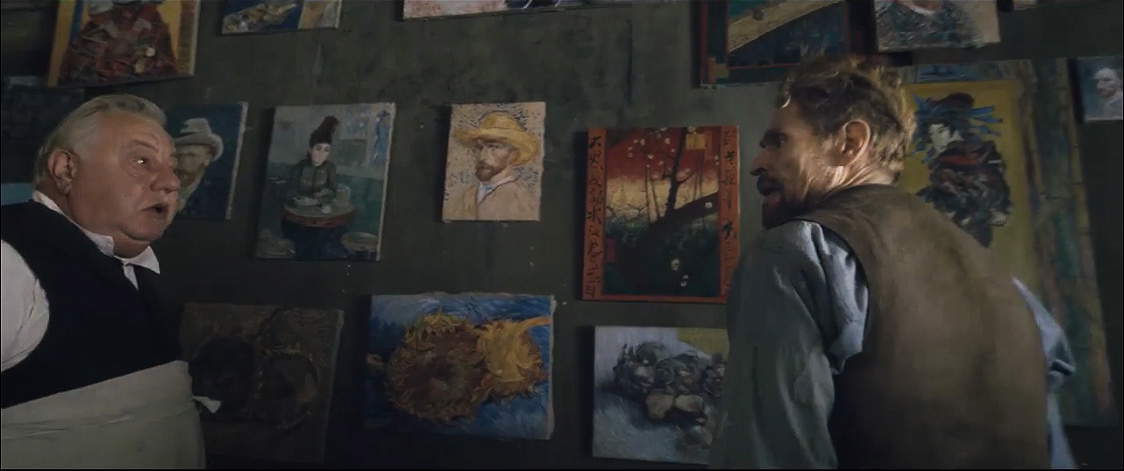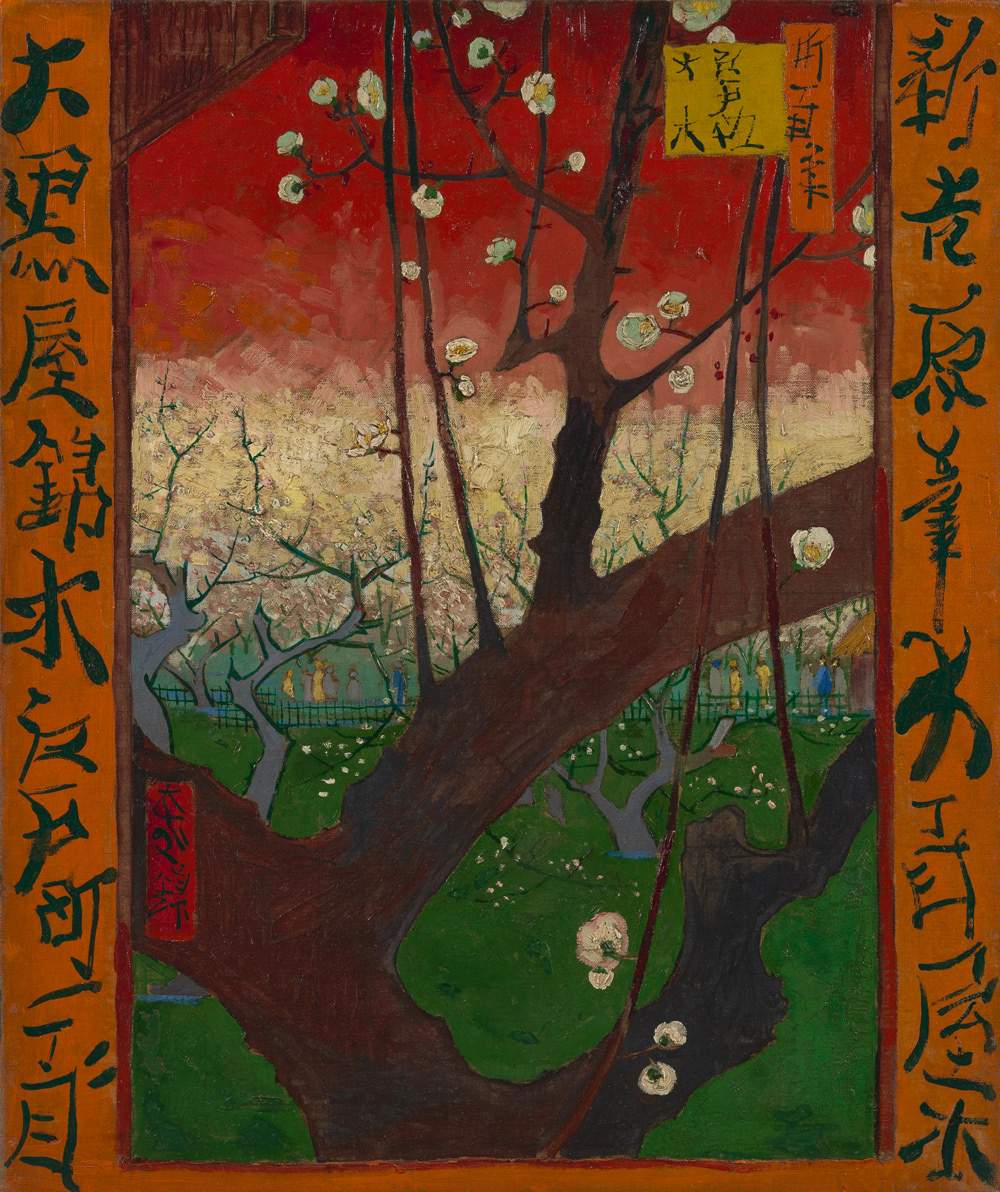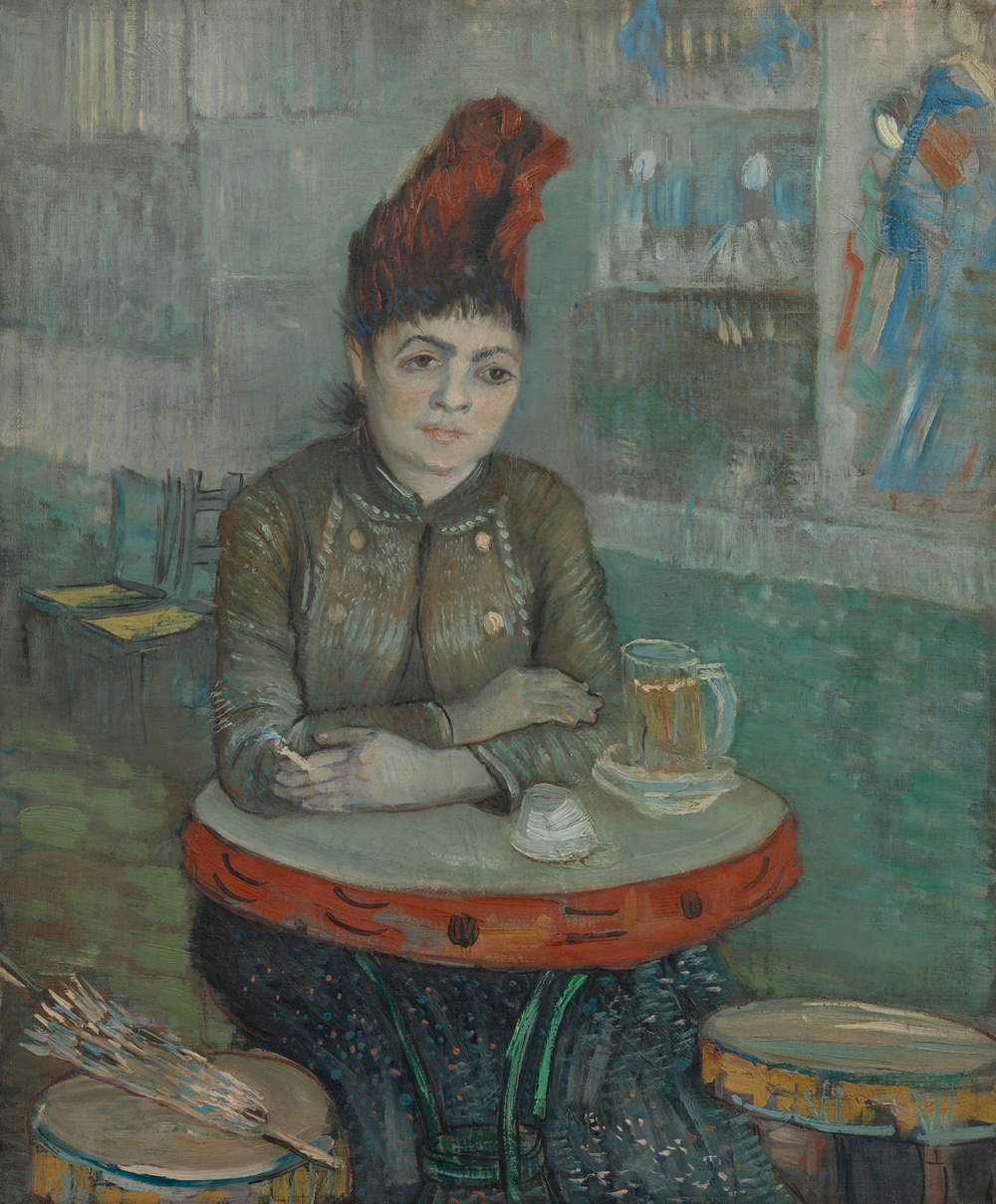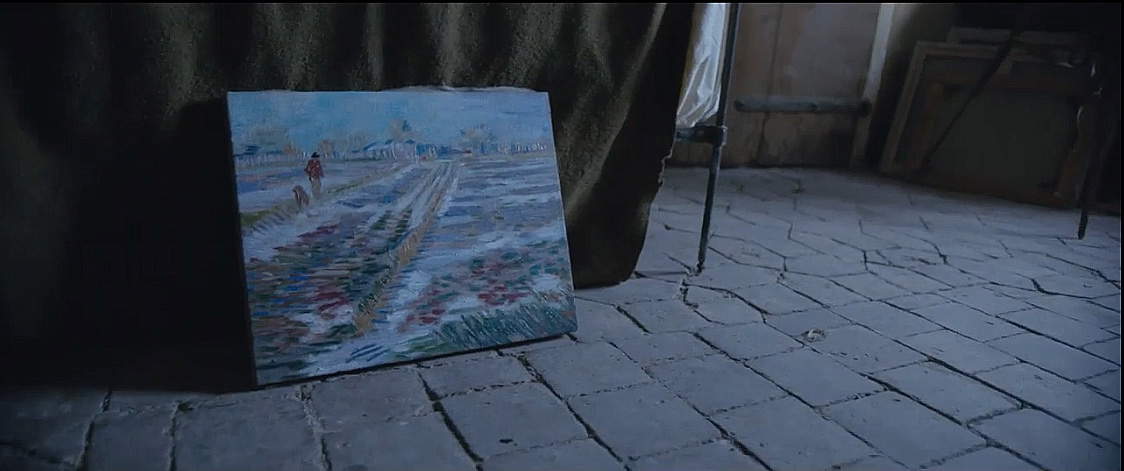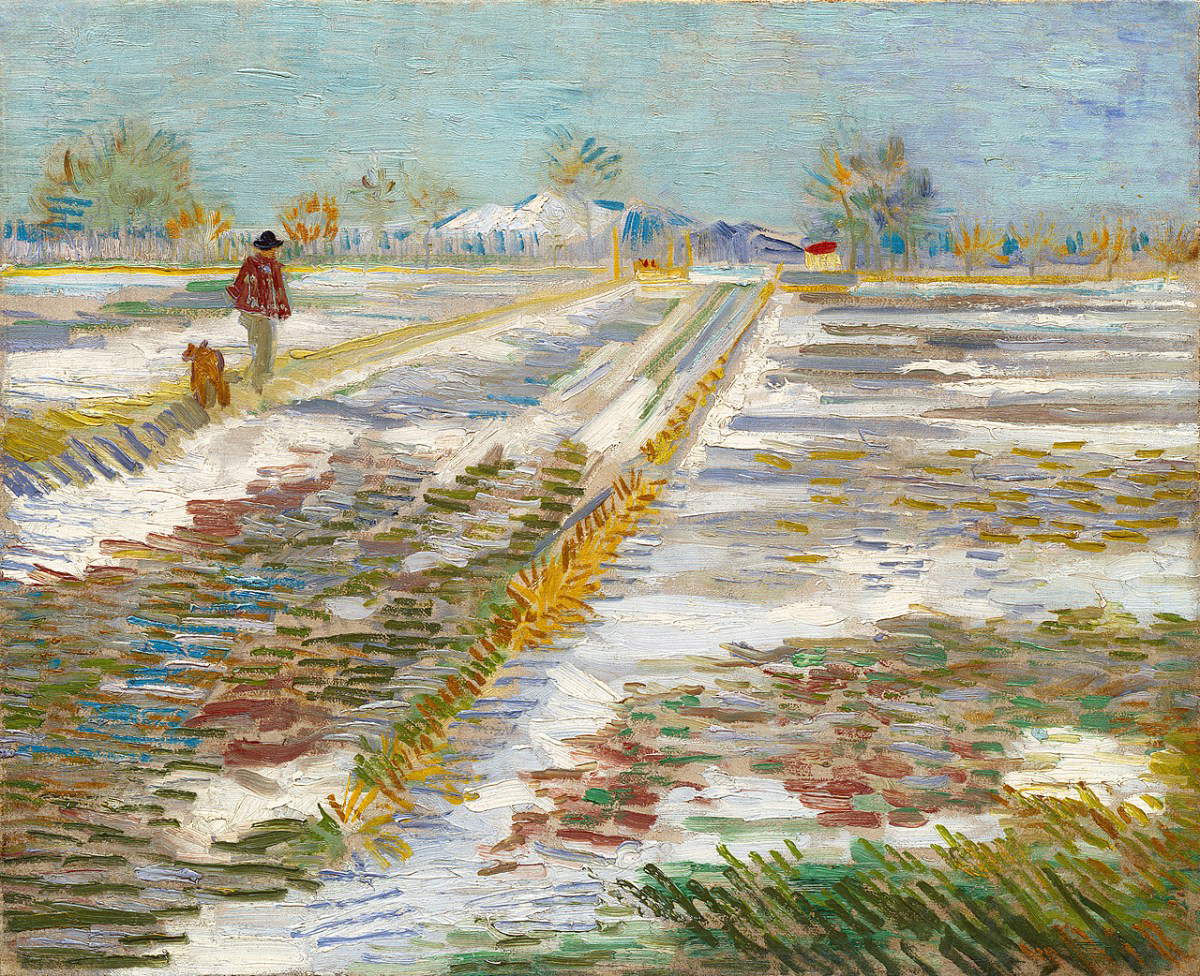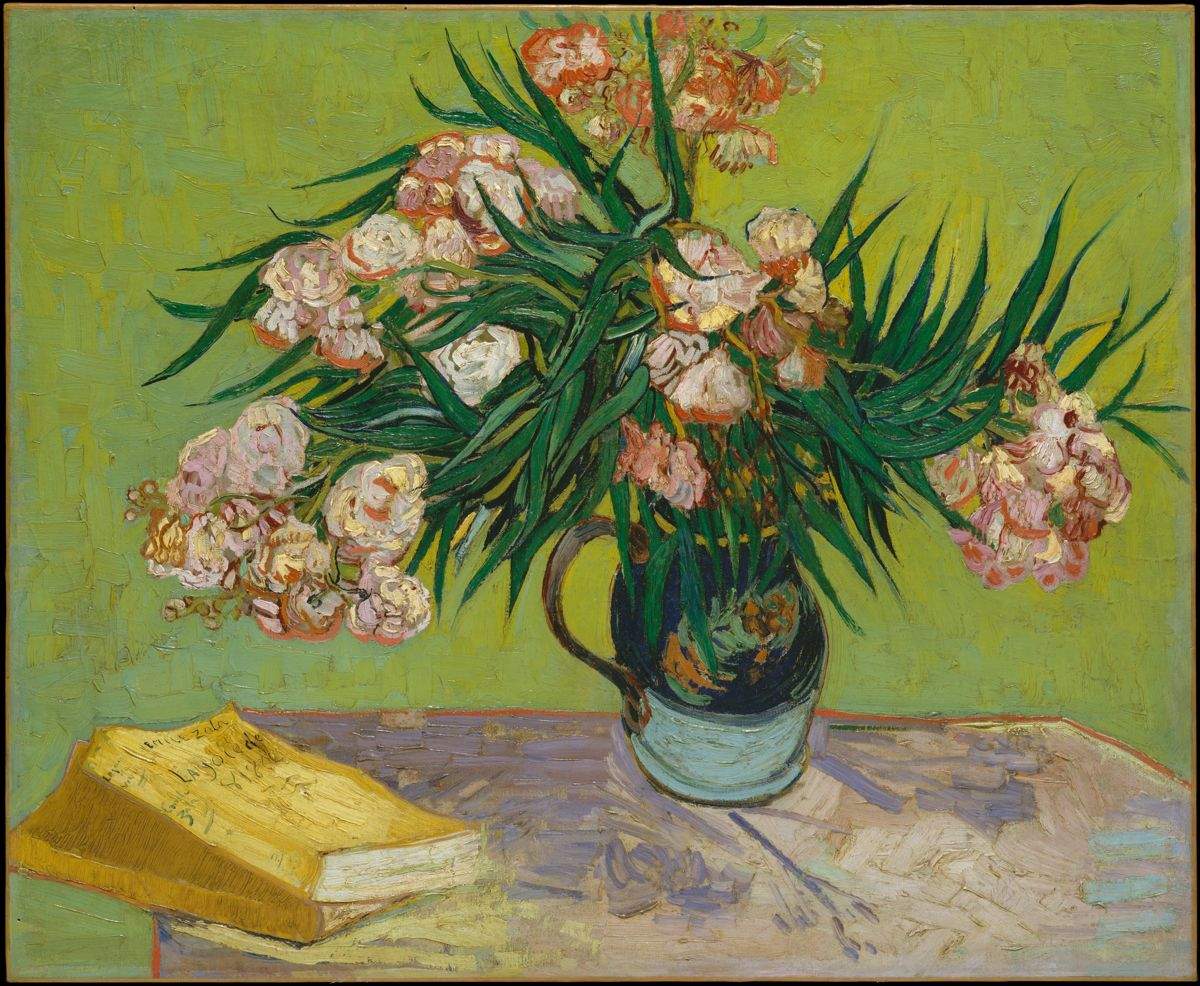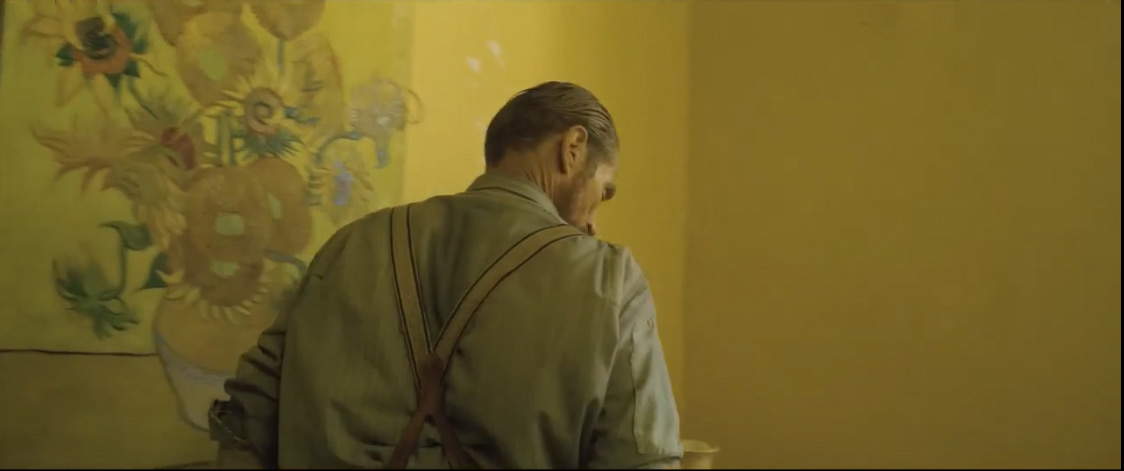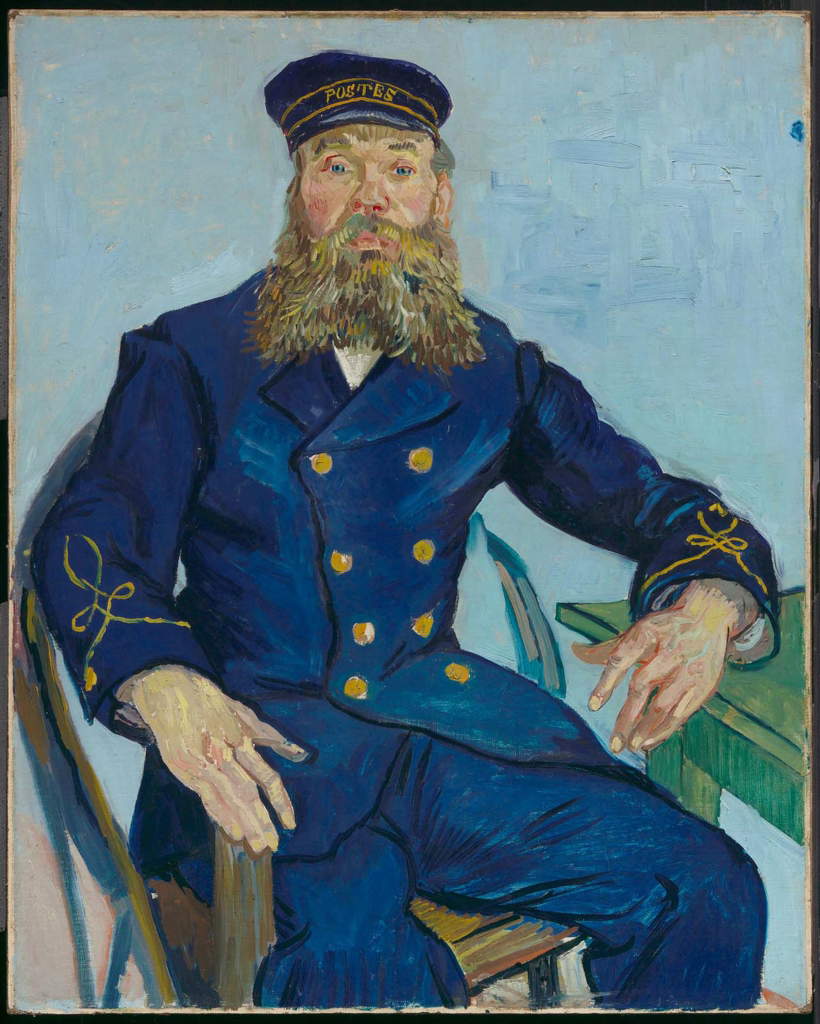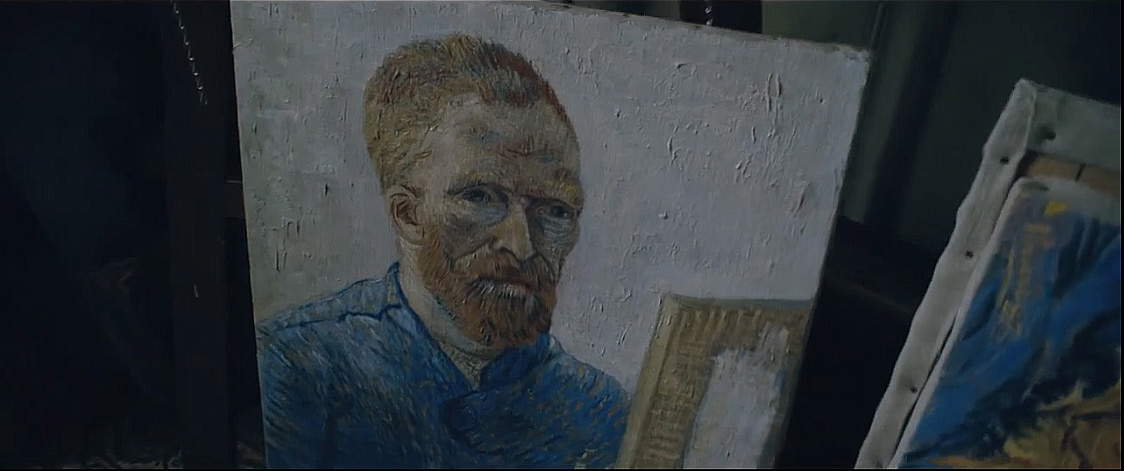by Federico Giannini, Ilaria Baratta , published on 04/01/2019
Categories: Works and artists
/ Disclaimer
In the film "Van Gogh. On the Threshold of Eternity" several works by Vincent van Gogh appear. We have selected ten of them, offering the frame of the film in which they appear, the image of the actual work, and a brief description.
One of the special features of the film Van Gogh. On the Threshold of Eternity, to be released in Italian theaters on January 3, 2019( an in-depth look at why to see it can be found atthis link ), consists in the fact that the paintings seen in the scenes of the film directed by Julian Schnabel are not simply reproductions of the works of Vincent van Gogh (Zundert, 1853 - Auvers-sur-Oise, 1890), but are works made from scratch, real paintings that the director wanted to be created from scratch. “The act of painting,” Schnabel in fact explained, “had to be authentic, and I wanted to make a film that faithfully reproduced what painters think and also what the relationship of us artists is with other painters, including those who lived before us.”
The lead actor, Willem Dafoe, who takes on the role of the great Dutch painter (and who won the Coppa Volpi at the 75th Venice Film Festival for his performance), had to learn how to paint. “This is a film that is as much about painting as it is about Van Gogh,” the actor explained, “so a lot of the work for me consisted of learning how to paint, and even more of learning how to observe. We started very simply, with me studying the materials and how to hold the brush in my hand. Then Julian started asking me to paint on my own. It cannot be said that I became a real painter in this short period of time, but I feel that what Julian taught me helped me to see things differently.” Julian Schabel is not only a successful filmmaker, but he is also, and more importantly, an internationally renowned artist. “In a very real way,” Dafoe adds, “he made me approach Vincent’s reality more deeply, because he made me discover what it’s like to witness the changes in perception that happen as you work. It made me better understand some aspects of art that I thought I already knew but didn’t really know. I learned how to touch a canvas, how to approach color, what strategies to adopt and how to then abandon each strategy. Above all, I realized that painting is a combination of inspiration, impulse, technique, practice and then abandoning practice. One of the things I like most about the film is that it manages to document part of this process, something we rarely get to see.”
Dafoe has thus ventured into the business of replicating real Vincent van Gogh paintings. There are several famous paintings that are seen throughout the film. In this in-depth look at ten of them closely, offering the frame of the film in which they appear, the image of the real painting, and a brief description.
1. Plum Blossom
(1887; oil on canvas, 55.6 x 46.8 cm; Amsterdam, Van Gogh Museum)
 |
| Frame from the film Van Gogh. On the Threshold of Eternity. |
The film opens in early 1888 Paris: Vincent van Gogh has set up his own exhibition at a café in the French capital (the film does not specify which one), but it turns out to be a failure, and the owner of the business (played by Belgian actor Vincent Grass) rudely invites him to remove his paintings and leave. Here’s the dialogue:
- I want to get rid of all this stuff now! You had talked about a group exhibition, with real artists. These are all yours. All of them! Where are the others? No one comes to see you. No one. Yes, all right one customer came. Just one. But the idea was to attract customers, not scare them away! This stuff needs to go away, now!
- But it was supposed to last two more weeks...
- Instead it ends today. That’s enough!
- What is it that you don’t like?
- Nothing, get it? I don’t like anything!
Among the works that can be seen behind van Gogh and the café owner is the 1887
Plum Blossom, a
japonaiserie (i.e., a painting with a Japanese subject) that the painter made from an 1857 print of Hiroshige’s
Kameido Garden. Van Gogh, since he had moved to Antwerp in 1885, had begun to collect Japanese prints: they were in fact objects that could be bought very cheaply, and van Gogh was always very fascinated by everything that came from the Far East, so much so that his decision to move to Arles was also motivated by a desire to find in Provence a light similar to that of the Land of the Rising Sun. To learn more about the relationship between van Gogh and Japanese art, you can read
our magazine’s article on the subject.
 |
| Vincent van Gogh, Plum Tree in Bloom (1887; oil on canvas, 55.6 x 46.8 cm; Amsterdam, Van Gogh Museum) |
2. Café: Agostina Segatori at Le Tambourin
(1887; oil on canvas, 55.5 x 47 cm; Amsterdam, Van Gogh Museum)
 |
| Frame from the film Van Gogh. On the Threshold of Eternity |
Also in the opening scene, the one of the exhibition at the Parisian café, at the moment when van Gogh asks, extremely dismayed and in a resigned tone, what the owner does not like, we see him taking in the portrait of Agostina Segatori at Café Le Tambourin. The work was done in Paris in early 1887: Agostina Segatori was the owner of Café Le Tambourin, which van Gogh used to frequent at the time of his Paris sojourn, and where he also had the opportunity to exhibit his paintings, as well as his own collection of Japanese prints, with the aim of selling them. Agostina Segatori (Ancona, 1841 - Paris, 1910) had moved to Paris at a very young age: we have no news about her childhood, nor do we know who her parents were, but we are certain that as early as 1860 she was in the French capital, where she had begun to pose for artists (an extraordinary portrait of her, now in the National Gallery of Art in Washington, was painted by Jean-Baptiste-Camille Corot). Van Gogh portrays her sitting at a bar table, smoking a cigarette with, in front of her, a mug of beer. It should be noted that, at the time, it was considered disreputable for a woman of good character to show herself at the bar intent on drinking and smoking, and women who did so enjoyed low social esteem.
 |
| Vincent van Gogh, At the Café: Agostina Segatori at Le Tambourin (1887; oil on canvas, 55.5 x 47 cm; Amsterdam, Van Gogh Museum) |
3. Snowy Landscape
(1888; oil on canvas, 38.2 x 46.2 cm; New York, Solomon R. Guggenheim Museum)
 |
| Frame from the film Van Gogh. On the Threshold of Eternity. |
In one of the opening scenes of
Van Gogh. On the Threshold of Eternity, we see the so-called
Snowy Landscape that the artist made in Arles in February 1888, shortly after his arrival. The artist’s first impression with the small Camargue town was not a happy one: in fact, van Gogh arrived there in the middle of winter and found Provence snow-covered, contrary to his expectations (although later, with the arrival of spring, his attitude changed, as soon as he was able to appreciate the region’s Mediterranean light). However, the icy winter of that year did not prevent the Dutch artist from expressing his creativity, and as soon as he arrived in Arles he produced this painting, now one of his most famous. In this depiction of the Provence countryside, where the only human presence is a character wandering through the fields with his dog (and who is probably on his way to the cottage we see in the distance: the red accent of the roof is the most ringing detail in the whole composition), the suggestion exerted by Japanese art is still palpable. The
Snowy Landscape was the subject of a
curious episode in early 2018: the president of the United States, Donald Trump, had requested the work on loan to the Guggenheim Museum for display in the Oval Office of the White House. The New York institution had responded in the negative, however, offering him as a replacement
Maurizio Cattelan’s work
America, the world-famous 18-karat gold toilet that the Padua-based artist created especially for the Guggenheim.
 |
| Vincent van Gogh, Snowy Landscape (1888; oil on canvas, 38.2 x 46.2 cm; New York, Solomon R. Guggenheim Museum) |
4. Shoes
(1888; oil on canvas, 45.7 x 55.2 cm; New York, The Metropolitan Museum of Art)
 |
| Frame from the film Van Gogh. On the Threshold of Eternity |
Vincent van Gogh’s attention to everyday objects is not uncommon. Shoes, in particular, return several times: this is a subject that the Dutch painter had already depicted during his stay in Paris and on which he also focused during his stay in Provence. The
Shoes currently housed at the Metropolitan Museum in New York were made in Arles in 1888, and this version stands out from the others because it is the only one in which a picture floor appears, a precise spatial reference: scholars have found that it is the floor of the famous “yellow house,” where van Gogh resided during his stay in Arles. The shoes could therefore be his, but some speculate that they are the shoes of Patience Escalier, a local farmer portrayed by van Gogh in another famous painting. The shoes could in fact be a symbol of the artist’s empathy for the peasants, whose suffering he intended to give voice to from the very beginning of his career (not least because van Gogh was an avid reader of the works of socially engaged writers).
 |
| Vincent van Gogh, Shoes (1888; oil on canvas, 45.7 x 55.2 cm; New York, The Metropolitan Museum of Art) |
5. Oleanders
(1888; oil on canvas, 60.3 x 73.7 cm; New York, The Metropolitan Museum of Art)
 |
| Frame from the film Van Gogh. On the Threshold of Eternity |
The
Oleanders now at The Metropolitan in New York are featured in one of the film’s most interesting dialogues, during which the Zundert artist’s idea of “eternity” first emerges. Van Gogh is found painting in the presence of Gabby (a fictional character, she is the janitor at the hotel where the painter is staying in the early days after his arrival in Arles, and is played by Julian Schnabel’s daughter, Stella), and the two exchange some jokes about the work:
- The flowers, why do you paint them?
- Don’t you find them beautiful?
- They are beautiful flowers of course. More than the way you paint them.
- Do you think so?
- Sure.
- Maybe you are right. But those flowers will wither and die, like all flowers.
- I know, everyone knows.
- While mine will endure.
- Are you sure?
- At least they will have a chance.
Van Gogh associated oleanders, the flowers featured in this work (the artist arranges them inside a majolica vase), with positive feelings: evidence of this is the fact that in the composition the flowers appear close to �?mile Zola’s book,
La joie de vivre, another tangible proof of the artist’s literary interests. The work was created in Arles in 1888.
 |
| Vincent van Gogh, Oleanders (1888; oil on canvas, 60.3 x 73.7 cm; New York, The Metropolitan Museum of Art) |
6. Sunflowers
(1889; oil on canvas, 95 x 73 cm; Amsterdam, Van Gogh Museum)
 |
| Frame from the film Van Gogh. On the Threshold of Eternity |
Probably the most famous work seen in the film,
Sunflowers appears in the version painted in Arles in January 1889 and currently housed in the Van Gogh Museum in Amsterdam. There are five paintings with Sunflowers in the Vase as their subject that are in public collections (in addition to the one in Amsterdam, there is one in the Philadelphia Museum of Art, one in the National Gallery in London, one in the Sompo Japan Museum of Art in Tokyo, and one in the Neue Pinakothek in Munich), and in addition to these there is one in private collections, and a seventh, once in Japan, was destroyed in August 1945 during U.S. air strikes against the Japanese during World War II. Van Gogh painted his sunflowers using only various
nunances of yellow, to demonstrate how it is possible to create works of art even with only one color without losing intensity. We also know that the sunflowers, which the artist painted to decorate the house he had rented in Arles (in the film, in fact, van Gogh is caught in the act of hanging on a wall the work now in Amsterdam) had an important meaning for him: in fact, the painter associated them with gratitude, as he had occasion to write in his letters. On January 22, 1889, he wrote a message from Arles to the then 29-year-old Dutch painter Arnold Koning, his friend, in which van Gogh said, “In all this time I have painted many studies and paintings. Among others I made this summer were two floral still lifes with nothing but sunflowers in a yellow terracotta vase. Painted with chrome yellow, ochre and Veronese green, and nothing else.”
 |
| Vincent van Gogh, Sunflowers (1889; oil on canvas, 95 x 73 cm; Amsterdam, Van Gogh Museum) |
7. The Postman Joseph Roulin
(1888; oil on canvas, 81.3 x 65.4 cm; Boston, Museum of Fine Arts)
 |
| Frame from the film Van Gogh. On the Threshold of Eternity |
Mr. Joseph Roulin was a letter carrier on duty in Arles and soon became a friend of Vincent van Gogh, who made him the subject of one of his most famous portraits, probably because of his appearance and bearing, which were particularly evocative to the artist. Thus he wrote on July 31, 1888, to his brother Theo: “I am now working with another model, a letter carrier in a blue uniform with gold trimmings, and a large face with a beard, reminding me of Socrates. A wild republican, like père Tanguy. A more interesting man than many other people.” Indeed, van Gogh’s portrait gives the humble letter carrier a very high dignity: he no longer looks like a letter carrier, but almost like a naval commander, with his blue decorated uniform, his composed pose, almost like an official portrait, his proud gaze pointed straight ahead. Joseph Roulin’s closeness to Vincent van Gogh is evidenced by the many other portraits the artist made of him, which are now preserved in various collections around the world (and we also know of some portraits of his family members, starting with Joseph’s youngest daughter Marcelle, who was just four months old when Vincent portrayed her).
 |
| Vincent van Gogh, The Postman Joseph Roulin (1888; oil on canvas, 81.3 x 65.4 cm; Boston, Museum of Fine Arts) |
8. The Starry Night
(1889; 73.7 x 92.1 cm; New York, MoMA - Museum of Modern Art)
 |
| Frame from the film Van Gogh. On the Threshold of Eternity |
“This morning I saw the countryside from my window long before the sun rose, with nothing but the morning star, which seemed very large to me. Daubigny and Rousseau have already painted it, expressing all the intimacy and all the peace and majesty it has, adding to it a feeling so heartbreaking, so personal.” So wrote Vincent van Gogh to his brother Theo from Saint-Rémy-de-Provence on a day between May 31 and June 6, 1889: the vision the artist describes in the missive is the one that would give rise to one of his most famous masterpieces,
The Starry Night. The “morning star” he refers to is the planet Venus, which is particularly bright at the crack of dawn in the last days of May: in the work, Venus is the star shining with whitish light at the bottom, near the tall cypress tree that divides the composition. What we observe in
The Starry Night is not a real landscape: the elements are the result of the artist’s invention (this is especially evident when observing the spire of the church: there are no similar ones in the area of France where the painter was at the time), who with this work wants to give substance to an interior vision, of great strength, extremely engaging, capable of evoking feelings of peace and quiet, and also of referring to a heartfelt dreamlike dimension (for van Gogh, looking at the stars is a way of dreaming).
 |
| Vincent van Gogh, The Starry Night (1889; 73.7 x 92.1 cm; New York, MoMA - Museum of Modern Art) |
9. Self-Portrait as Painter
(1887-1888; oil on canvas, 65.1 x 50 cm; Amsterdam, Van Gogh Museum)
 |
| Frame from the film Van Gogh. On the Threshold of Eternity |
Throughout his career, Vincent van Gogh produced a very large number of self-portraits. There are only two self-portraits, however, in which he presents himself with the tools of the trade, and this is the last known, as well as the last ever work from his Paris sojourn (it was made between December 1887 and February 1888). Of this self-portrait, the painter spoke in a letter sent from Arles to his sister, Willemien, between June 16 and 20, 1888: “since I am very busy with myself, I would like to see if I am able to make my portrait with writing. First I would begin by saying that, in my opinion, the same person can provide materials for very different portraits. Here is an impression of me, which is the result of a portrait I painted in the mirror, and which Theo possesses: a pinkish-gray face with green eyes, ash-blond hair, wrinkles on the forehead to around the mouth, severely stiff, a red beard, rather unkempt and sad, but the lips are full, there is a rough linen shirt, and a palette with lemon yellow, vermillion, Veronese green, cobalt blue, in short all the primary and secondary colors, except the orange of the beard.” Orange is actually on the palette as well, but van Gogh excluded it from the list because he included it in two different shades. Van Gogh knew color theory and knew that using complementary colors would brighten the painting: thus, the orange of the beard is opposed by its complementary color, the blue of the shirt.
 |
| Vincent van Gogh, Self-Portrait as Painter (1887-1888; oil on canvas, 65.1 x 50 cm; Amsterdam, Van Gogh Museum) |
10. Dr. Paul Gachet
(1890; oil on canvas, 68 x 57 cm; Paris, Musée d’Orsay)
 |
| Frame from the film Van Gogh. On the Threshold of Eternity. |
On the ending of
Van Gogh. On the Threshold of
Eternity, the artist, having moved from Arles to Auvers-sur-Oise, has a discussion with Dr. Paul Gachet, the doctor who had been treating him (and who was, moreover, a passionate art collector). In the dialogue, van Gogh returns to the subject of eternity:
- Why do you paint?
- I paint ... actually to stop thinking.
- It is a kind of meditation....
- When I paint I stop thinking.
- Thinking about what?
- I stop thinking and I feel... being part of whatever is outside and inside me. I wanted ... so badly to share what I see. An artist...
- Yes?
- I used to think that an artist... should teach how to look at the world, but now I don’t think that anymore. Now I just think about my relationship with eternity.
- What is eternity to you?
- Time to come.
- Perhaps you mean that your gift to the world is your painting.
- Otherwise ... what good is an artist?
- You are happy when you paint.
- Almost always, except when I fail.
- Sometimes you seem so sad.
- You know, a successful painting carries with it a baggage of destruction and failure. I find joy in pain. Pain is more powerful than laughter. You know -- an angel is not so distant from the afflicted. And sickness -- sometimes it can heal us. It is the normal state of mind from which a painting originates.
- Is it your state of mind?
- Sometimes I fear to find my salure again.
- In that case you don’t need a doctor!
Van Gogh executed at least two portraits of Dr. Gachet, one of which is the one preserved in the Musée d’Orsay. The painting remained, moreover, in the family collection after the doctor’s death: it was his children, Paul and Marguerite, who donated it to the French state in 1949, for the Jeu de Paume museum: it was exhibited here until 1986, when the work became part of the Musée d’Orsay collection. The doctor is portrayed with a meditative manner and a “melancholy expression,” as van Gogh himself called it in a letter sent to his sister Willemien in 1890: it was particularly apt, van Gogh pointed out, to embody “the disconsolate expression of our times.” And the dejectedness also appears clear from the color scheme the artist employed, all set on cool tones (and little enlivened by the presence of the flower on the table). The painting in the Musée d’Orsay is considered to be the second version of an original kept in a private collection and whose traces have been lost: in the original, to emphasize even more the meditative attitude of Dr. Gachet (who, unfortunately, could do nothing to prevent Vincent’s disappearance), a book also appeared on the table.
 |
| Vincent van Gogh, Dr. Paul Gachet (1890; oil on canvas, 68 x 57 cm; Paris, Musée d’Orsay) |
Warning: the translation into English of the original Italian article was created using automatic tools.
We undertake to review all articles, but we do not guarantee the total absence of inaccuracies in the translation due to the program. You can
find the original by clicking on the ITA button. If you find any mistake,please contact us.
